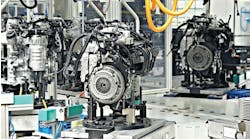Manufacturers around the world constantly seek ways to boost efficiency and for a good reason. Efficiency improvements can lead to cost savings, enhanced competitiveness and a stronger position in the global market. While there are many strategies to optimize manufacturing, the most effective path involves taking a comprehensive approach to your entire manufacturing process.
Defining Manufacturing Efficiency: Start with Clarity
Before embarking on the journey to improve manufacturing efficiency, it’s essential to define what it means for your company. Manufacturing efficiency is typically measured as the overall effectiveness of manufacturing maintenance and management. It quantifies the relationship between the output and the resources employed in production.
However, your specific products and processes may necessitate a tailored definition of efficiency. Therefore, begin by clarifying what efficiency means for your organization before you can take steps to enhance it.
How to Improve Productivity & Efficiency in Manufacturing?
Tracking Progress with Efficiency Metrics
The old saying holds true: If you can’t measure it, you can’t improve it. Various efficiency-related metrics can help you gauge your progress in enhancing manufacturing efficiency. Your choice of metrics should align with your unique requirements and objectives. Some common efficiency metrics include:
- Overall Equipment Efficiency (OEE)
- Total Effective Equipment Performance (TEEP)
- Overall Operations Effectiveness (OOE)
- Throughput
- On Standard Operating Efficiency
- Asset Utilization
Each of these metrics offers insights into different facets of your manufacturing process. By tracking the relevant metrics, you can evaluate the impact of changes and improvements over time.
Leveraging Software for Efficiency Gains
Modern software solutions can be valuable allies in your quest for improved manufacturing efficiency. The choice of software depends on the specific areas of your operations that need optimization. Some popular software types include:
- Manufacturing Execution Systems (MES)
- Factory simulators, such as logistics, fluid or material handling simulation
- Enterprise Resource Planning (ERP) systems
- Robot simulation programs
These tools can help you streamline and automate various aspects of your manufacturing processes, making your operations more efficient and responsive.
Optimizing Plant Layout Design
The physical layout of your manufacturing facility plays a crucial role in efficiency. A poorly designed plant layout can result in longer travel distances, increased downtime and higher employee stress levels. To optimize your plant layout design, consider:
- Breaking tasks into manageable steps
- Minimizing unnecessary movements
- Tailoring automation solutions to your space constraints
A well-planned plant layout can significantly enhance manufacturing efficiency.
Invest in Employee Training
Efficiency is not solely about machines and processes; it heavily depends on your workforce. Properly trained employees are key to a more efficient operation. Besides ensuring regular safety training, maintain detailed training records for your team. Additional ways to boost employee efficiency include:
- Implementing personalized schedules to track individual progress
- Offering dedicated training on new equipment
- Providing access to industry resources and online tools for self-learning
Investing in employee training yields substantial benefits. One study found that a 10% increase in workforce education led to an average productivity boost of 8.6%.
Optimizing Inventory Management
Your inventory, both in terms of raw materials and finished products, is a valuable area for optimization. An effective ERP system can help you synchronize these inventory aspects. By automating triggers for materials billing, invoicing and inventory tracking, you can streamline inventory processes and reduce human error. This ensures that your stock remains at optimal levels, preventing shortages and enabling better responsiveness to shifts in demand.
Streamline Communication Across Departments
Efficient communication is critical, especially in manufacturing. Streamlining communication across all departments can help preempt potential issues before they escalate into problems. This includes addressing challenges related to inefficient project management, information overload and unrealistic targets.
Final Thoughts
Achieving manufacturing efficiency is a multifaceted endeavor that requires commitment and a comprehensive approach. By embracing these strategies and continually assessing and adjusting your processes, you can enhance efficiency, reduce costs and stay competitive in the global marketplace.









